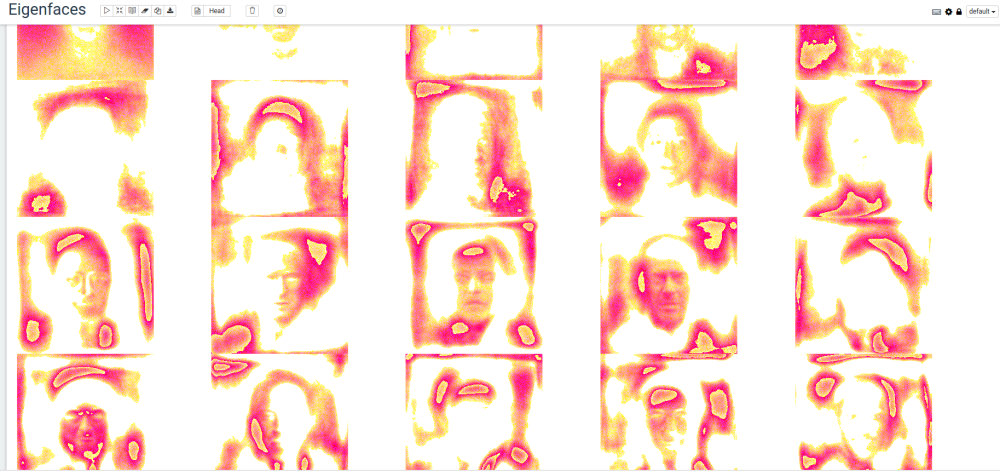Credit: original blog post by rawkintrevo. This will be maintained through version changes, blog post will not.
Eigenfaces are an image equivelent(ish) to eigenvectors if you recall your high school linear algebra classes. If you don’t recall: read wikipedia otherwise, it is a set of ‘faces’ that by a linear combination can be used to represent other faces.
Their are lots of “image recognition” things out there right now, and deep learning is the popular one everyone is talking about.
Deep learning will admittedly do better a recognizing and correctly classifying faces, however it does so at a price.
- Neural networks are very costly to train in the first place
- Everytime a new person is added, the neural network must be retrained to recognize the new person
The advantage/use-case for the eigenfaces approach is when new faces are being regularly added. Even when building a production
grade eigenfaces based system- neural networks still have a place- idenitifying faces in images, and creating centered and scaled images around
the face. This is scalable because we only need to train our neural network to detect, center, and scale faces once. E.g.
a neural network would be deployed as a microservice, and then eigenfaces would be deployed as a microservice.
A production version ends up looking something like this:
- Image comes in- is fed to ‘detect faces, center, scale- neural network based microservice’
- Neural network microservice detects faces, centers and scales. Passes each face to eigenfaces microservice
- For each face:
a. Decompose face into linear combination of eigenfaces
b. Determine if linear combination vector is close enough to any exististing vector to declare a match
c. If no match “add new person” to face corpus.
Get the data
The first thing we’re going to do is collect a set of 13,232 face images (250x250 pixels) from the Labeled Faces in the Wild data set.
cd /tmp
mkdir eigenfaces
wget http://vis-www.cs.umass.edu/lfw/lfw-deepfunneled.tgz
tar -xzf lfw-deepfunneled.tgz
Load dependencies
cd $MAHOUT_HOME/bin
./mahout spark-shell \
--packages com.sksamuel.scrimage:scrimage-core_2.10:2.1.0, \
com.sksamuel.scrimage:scrimage-io-extra_2.10:2.1.0, \
com.sksamuel.scrimage:scrimage-filters_2.10:2.1.0
Create a DRM of Vectorized Images
import com.sksamuel.scrimage._
import com.sksamuel.scrimage.filter.GrayscaleFilter
val imagesRDD:DrmRdd[Int] = sc.binaryFiles("/tmp/lfw-deepfunneled/*/*", 500)
.map(o => new DenseVector( Image.apply(o._2.toArray)
.filter(GrayscaleFilter)
.pixels
.map(p => p.toInt.toDouble / 10000000)) )
.zipWithIndex
.map(o => (o._2.toInt, o._1))
val imagesDRM = drmWrap(rdd= imagesRDD).par(min = 500).checkpoint()
println(s"Dataset: ${imagesDRM.nrow} images, ${imagesDRM.ncol} pixels per image")
Mean Center the Images
import org.apache.mahout.math.algorithms.preprocessing.MeanCenter
val scaler: MeanCenterModel = new MeanCenter().fit(imagesDRM)
val centeredImages = scaler.transform(imagesDRM)
Calculate the Eigenimages via DS-SVD
import org.apache.mahout.math._
import decompositions._
import drm._
val(drmU, drmV, s) = dssvd(centeredImages, k= 20, p= 15, q = 0)
Write the Eigenfaces to Disk
import java.io.File
import javax.imageio.ImageIO
val sampleImagePath = "/home/guest/lfw-deepfunneled/Aaron_Eckhart/Aaron_Eckhart_0001.jpg"
val sampleImage = ImageIO.read(new File(sampleImagePath))
val w = sampleImage.getWidth
val h = sampleImage.getHeight
val eigenFaces = drmV.t.collect(::,::)
val colMeans = scaler.colCentersV
for (i <- 0 until 20){
val v = (eigenFaces(i, ::) + colMeans) * 10000000
val output = new Array[com.sksamuel.scrimage.Pixel](v.size)
for (i <- 0 until v.size) {
output(i) = Pixel(v.get(i).toInt)
}
val image = Image(w, h, output)
image.output(new File(s"/tmp/eigenfaces/${i}.png"))
}
View the Eigenfaces
If using Zeppelin, the following can be used to generate a fun table of the Eigenfaces:
%python
r = 4
c = 5
print '%html\n<table style="width:100%">' + "".join(["<tr>" + "".join([ '<td><img src="/tmp/eigenfaces/%i.png"></td>' % (i + j) for j in range(0, c) ]) + "</tr>" for i in range(0, r * c, r +1 ) ]) + '</table>'
